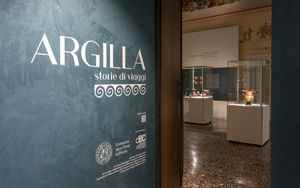(Tiper Stock Exchange) – Intesa Sanpaolo presents at Galleries of Italy – Vicenza the scientific and educational project “Clay. Travel stories”second appointment of the three-year cycle realized with the Department of Cultural Heritage of the University of Padua and important archaeological museums of the Veneto.
Edited by Monica Salvadori, Monica Baggio and Luca Zamparothe exposure “Clay. Travel Stories”open to the public until 18 June, intends to reflect on the aggregating role of Greek ceramics in the Mediterranean area – a source of inspiration, contamination, development – or rather on the ability of Athenian figurative specimens to interact with current audiences to facilitate understanding of the role of antiquity as the origin of our value system.
While the first stage of the journey has focused on the production methods of Greek and Magna Graecia ceramics, as well as on the relationship between ancient and contemporary manufacturing, the second edition want to face the travel theme, considering the significant presence of Greek and Magno-Greek vases in the museum collections of the Veneto region. This peculiar aspect, investigated from antiquity to the present day through the fundamental role played by the Republic of Venice, together with the awareness of the social and cultural role that the Greek ceramic heritage has played and continues to play in the definition of Western identity, provides the main reading key for understanding the research project, conceived with clear scientific and didactic intentions.
The three-year course, now on the second date after “Clay. Stories of vases”was born as part of the collaboration between the Art, Culture and Historical Heritage Department of Intesa Sanpaolo and the Department of Cultural Heritage of the University of Paduawithin the research developed by the Memo Project. Object memory. A multidisciplinary approach for the study, digitization and enhancement of Greek and Magna Graecia ceramics in the Veneto region, supported by the Cassa di Risparmio di Padova e Rovigo Foundation.
The collaboration project – explains Intesa Sanpaolo in a note – aims to offer the best use and knowledge of the cultural heritage thanks to a profitable synergy between public and private institutions, enhancing the precious finds preserved in the territorial network of archaeological museums and Greek ceramics and Magno-Greeks of the Intesa Sanpaolo collection, made up of over five hundred artifacts produced between the sixth and third centuries. BC, coming from Ruvo di Puglia, now exposed to Galleries of Italy in Naples and represented in the Vicenza itinerary by a nucleus of prestigious works.
Along with these, the exhibition allows you to admire artefacts from important archaeological museums in the Veneto region: the National Archaeological Museum of Adria and the National Archaeological Museum of Venice, the Civic Museum of Bassano del Grappa, the Museum of the Great Rivers of Rovigo and the Museum of Archaeological Sciences and Art and the University Center for the Museums of University of Padua.
Among the exhibited works, the Krater with red-figure columns depicting Peleus abducting Thetis of the Deepdene Painter, conserved at the Museo dei Grandi Fiumi in Rovigo and restored for the occasion by Intesa Sanpaolo. The crater represents the emblem of these journeys and of this narrative journey: an Attic artifact that has reached the Etruscan-Po Valley necropolis of Balone (Rovigo) which, over the centuries, describes the abduction of the sea goddess Teti by Peleus, hero of the expedition of the Argonauts; the marriage between the two, an anticipatory element of the Trojan War, will lead to the birth of Achilles who, as an adult, will make his last journey precisely to fight in that conflict.
Alongside the discovery of the wonders and secrets hidden in ancient ceramics, as well as the fundamental role of the territorial network that links museums and institutions, the concept of “design for all”, the design that aims to eliminate barriers in the use of places and objects, to accompany the visitor in the story of the exhibition. In fact, the new set-up continues in the attention toaccessibility and inclusiveness with new supports dedicated to a multisensory visit: in particular a new tactile book by the artist Elisa Lodolo, which tells about the journey and the dangers of shipwrecks, as well as an original rotating table, designed by the architect Michael Franzinawhich presents the different types of ceramics with 3D reproductions, each with its own function, also told through QRcodes that refer to the voice of the curators and videos in Italian Sign Language presenting the exhibition sections.
The project was presented in Vicenza at the Gallerie d’Italia athe presence of Michael Coppolaexecutive director of Art Culture and Historic Heritage Intesa Sanpaolo, of the rector of the University of Padua Daniela Mapelli, Of Monica Salvadoripro-rector curator of the exhibition together with Monica Baggio and Luca Zamparo, Of Julia Pelucchini representing Vincenzo Tinè for the Superintendence of Archaeology, Fine Arts and Landscape for the provinces of Verona, Rovigo and Vicenza, the Director General of the Veneto Museums Daniel Ferrara, and of the directors and conservators of the lending museums. They were also present Jacopo Bonettodirector of the Department of Cultural Heritage e Barbara Arfe, delegate for inclusion and disability at the University of Padua. Also present were representatives of theItalian Union of the Blind, which has actively collaborated in the accessibility project and other associations and organizations involved in inclusion issues.
